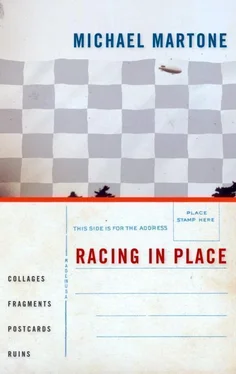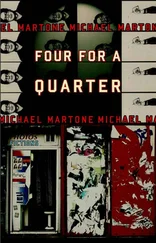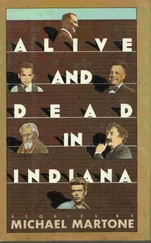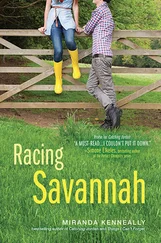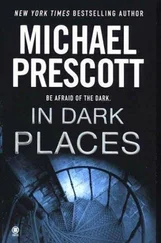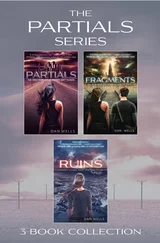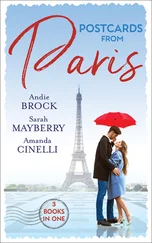7
I grew up in Fort Wayne, Indiana. When I was a child my father took me to see the dwarf houses on the north side of town. There was a little village of dwarf houses, six or seven of them, tucked within a neighborhood of larger houses not far from where the river curved toward the hill where Johnny Appleseed is buried. The dwarf houses looked like the regular houses around them except for their size. The houses were smaller in every regard. The scale was dwarf scale. They were bigger than play houses. They were smaller than house houses. Their parts and the materials used in the construction-the doors and windows, porches and chimneys, the shingles and clapboards-were identical to my house save that they were a quarter of the size. We drove back and forth on the road in front of the houses. The mailboxes on the street were the regulation-sized mailboxes but the pole they were perched on was thigh high. My father pointed out how big the meter boxes looked, how the parked cars in the driveway were like regular parked cars, how the silver propane tanks, well, dwarfed the houses like zeppelins moored to their hangers. I suppose we were waiting to see who would emerge from the tiny doorways to check the mail or pick up the paper or water the postage-stamp-sized lawn. We never did catch sight of any of the inhabitants. My father had heard that this was a winter camp of traveling performers. The houses were empty most of the year, the owners on the road with carnivals and sideshows. But even that we were never able to really prove-probably an urban legend. I took my son to see the dwarf houses. He was then the age I had been when my father first took me to see them. It was Christmas and there were little icicle lights hanging from the miniature eaves, halfway down the side of the houses. You know the feeling when you return to look at the houses you grew up in or when you haunt the neighborhoods of your childhood? You have the sensation that everything is smaller-the houses, the trees, the lawns. Memory gives you a map more detailed than the original. The original is underwhelming, shrunken, contracted, lacking. But visiting the dwarf houses I had visited again turned out different. The dwarf houses seemed larger than I remembered them. I drove with my son back and forth around the little grid of narrow streets lined with the dwarf houses. There were lights on, and the Christmas decorations twinkled. The walks had been shoveled and the snow piled up into piles. Smoke seeped from the chimneys. We didn't see anyone. So I drove over to my old neighborhood to show my son the tiny tiny house where I remember growing up.
Sixteen Postcards from Terra Incognita


Numbered in the way they were written, not the way they were delivered
One of Sixteen: Wish You Were Here
The poignancy of postcards stems from that expressed or, at least, implied desire: Wish you were here! Penned when "here" is so not "there" yet addressed to a "you" important enough to make the "you" who writes the postcard forgetful of the "here" where that "you" writes. To write a postcard is actually (in the midst of not being there but being here) to transport yourself to the "there" of the addressee. The genre of the postcard embeds an address in its text like the ghazal insists upon the encoding of the poet's name into the verse. To write a postcard is to caption its caption, to continually locate and place yourself in a place all the time imagining another place, the "there," of the recipient.
Two of Sixteen: Thinking of You
The postcard is place inscribed, dramatized, and animated. It is a place that moves. A piece of place that has broken off and… I like to break the proscribed boxed boundary of the space "This Space for Message" message. I write on the photo, verso. I arrow in on the window, the third floor, third from the left. I affix the legend: I am here. There are other windows on the card. Think: the stamp is the postcard's postcard. Thinking of you! Indeed. Thinking of you, there, thinking of me, here, wishing you were here with me, me there with you. The postcard is a koan of place, our having to be somewhere, and our relationship to place and to each other. It is a place, a place in and of itself. Thinking of you! Wish you were here!
Five of Sixteen: Why Fort Wayne
It is hard to imagine now but for a while this plot of ground was to die for. Three American forts were built here. Four French. Three British. The Miami and the Shawnee each had fortified villages. There were massacres, ambushes, running battles, forced marches, insurgences, sieges, conflagrations, surrenders. Torture. Spy Run Creek, it is said, ran red with blood. This place was, for a while, geopolitically present. And place always contains its component of time. A strip of ten miles of land, a continental divide actually, that separates the Great Lakes Basin from the Mississippi Valley, was strategic if one moved around by water. But we, long ago, no longer moved around by water. And this contested portage, overnight, became, quite literally, just another backwater, no longer bothered to defend. Attention shifts and drifts through time. It lights on and lights up a place for an instant. Now you see it. Now you don't.
Three of Sixteen: There Is No Here Here
I love the map pieced together from the montage satellite photos (like postcards) representing the United States at night. There are great globs of light, dentritic phosphorescent tendrils netting up metropolises, the pearlescent bacterial glowing culture. And then there is the negative space, the absence of light, the empty negated vastness. I imagine that in the black blankness the grid of place is waiting to be sparked, that it is a story or a poem that provides the juice, switch it on. How does a place become a place? Donald Barthelme in "The End of the Mechanical Age" imagines God as a meter reader and tells us that grace is not like electricity, it is electricity. Let there be light. Write "light" and there is light.
Four of Sixteen: Look Out There
Once flying at night from coast to coast I happened to look out the window and spotted the burning blots spotting, their shimmering splatter radiating on the ground below. There, suddenly, was Fort Wayne, all its distinguishing features in place (the quirky cant of its downtown street grid askew, looking like itself, itself assembling itself before my eyes into a here down there).
Six of Sixteen: The Necropolis Leads the Metropolis
City planners once imagined that cities, civilization itself, sprang from our ancestors' decision to simply settle down. Time was right to build a town. But I like the new theory promoted by the trade that cities were a consequence of something other than a conscious shift away from hunting and gathering, slashing and burning. No, humans changed their practice of burial. They began to bury the dead and tending the graves stopped the migration. Bury the dead and this precipitates the living out of the flow. They hole up. To tend the dead. Tending the dead necessitated construction of shelter, the spur for agriculture, the undertaking of specialized individual tasks. The Necropolis leads the Metropolis, you see, not the other way around. Oh it is the chicken or egg thing, I realize. But I like the notion of tending the dead. Tending the dead, the job description of the writer attuned to the steady erosion, the evaporation of the details of time and place, of everything and everyone's re-placement. Stories can be thought of as vast cemeteries of the past place, affixed now in neat rows of print. How does a place become a place? Perhaps through accumulation of stories. A plot defined by plots.
Читать дальше
